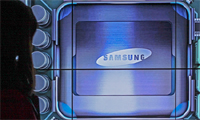



Date:17/04/19
 Samsung announced it has completed work and is taking orders for a 5nm foundry process using extreme ultraviolet lithography. It will offer 25% greater density and either 10% more performance or 20% less power consumption than its 7nm node with EUV announced in October.
Samsung announced it has completed work and is taking orders for a 5nm foundry process using extreme ultraviolet lithography. It will offer 25% greater density and either 10% more performance or 20% less power consumption than its 7nm node with EUV announced in October.
Samsung has taped out “many” 7nm chips as well as one device in a so-called 6nm node that lets users make custom changes to its 7nm process and IP blocks. It also announced plans to start production in 2020 on a second EUV foundry line it is now setting up next to its current S3 line in Hwaseong, Korea.
With the news, the Korean giant aims to steal some thunder from larger rival TSMC, which is scheduled to give an update on its work on a 5nm node next week. The two are racing to capture a lucrative but shrinking market for leading-edge process technology at a time when it’s becoming more complex and costly to make chips smaller and faster.
Samsung declined to share line widths and pitches used on its 5nm node or relative costs of the new process.
“We’ve been using EUV on 7nm mostly in the back end, but for 5nm we are adding a little more [use of EUV] to the middle of the line,” said Shawn Han, a senior vice president for Samsung’s foundry group. “We are in a leadership position for EUV productivity,” he added, declining to share specifics about EUV wafer throughput, uptime or defect levels.
“All the teams in the industry are working to secure the [best] source power, defect-free masks and enhancements in materials for [EUV] photoresists…Our advantage is we have in-house mask-making facilities where we’ve been building up know-how,” Han said.
In October, Samsung said it’s EUV throughput was at or above 1,500 wafers/day. It’s light source delivered a 250W sustained performance and a 280W peak, though it targeted 300W.
The 25% density gain and 10% performance boost or 20% power decline for the 5nm process marks a relatively minor advance. In October, Samsung said its 7LPP process would deliver up to a 40% shrink and up to 20% higher speeds or 50% lower power consumption compared to its 10nm node.
Samsung Ready with 5nm EUV
 Samsung announced it has completed work and is taking orders for a 5nm foundry process using extreme ultraviolet lithography. It will offer 25% greater density and either 10% more performance or 20% less power consumption than its 7nm node with EUV announced in October.
Samsung announced it has completed work and is taking orders for a 5nm foundry process using extreme ultraviolet lithography. It will offer 25% greater density and either 10% more performance or 20% less power consumption than its 7nm node with EUV announced in October.Samsung has taped out “many” 7nm chips as well as one device in a so-called 6nm node that lets users make custom changes to its 7nm process and IP blocks. It also announced plans to start production in 2020 on a second EUV foundry line it is now setting up next to its current S3 line in Hwaseong, Korea.
With the news, the Korean giant aims to steal some thunder from larger rival TSMC, which is scheduled to give an update on its work on a 5nm node next week. The two are racing to capture a lucrative but shrinking market for leading-edge process technology at a time when it’s becoming more complex and costly to make chips smaller and faster.
Samsung declined to share line widths and pitches used on its 5nm node or relative costs of the new process.
“We’ve been using EUV on 7nm mostly in the back end, but for 5nm we are adding a little more [use of EUV] to the middle of the line,” said Shawn Han, a senior vice president for Samsung’s foundry group. “We are in a leadership position for EUV productivity,” he added, declining to share specifics about EUV wafer throughput, uptime or defect levels.
“All the teams in the industry are working to secure the [best] source power, defect-free masks and enhancements in materials for [EUV] photoresists…Our advantage is we have in-house mask-making facilities where we’ve been building up know-how,” Han said.
In October, Samsung said it’s EUV throughput was at or above 1,500 wafers/day. It’s light source delivered a 250W sustained performance and a 280W peak, though it targeted 300W.
The 25% density gain and 10% performance boost or 20% power decline for the 5nm process marks a relatively minor advance. In October, Samsung said its 7LPP process would deliver up to a 40% shrink and up to 20% higher speeds or 50% lower power consumption compared to its 10nm node.
Views: 348
©ictnews.az. All rights reserved.Similar news
- Azerbaijani project to monitor disease via mobile phones
- Innovative educational system to be improved under presidential decree
- NTRC prolongs license of two TV and radio organizations for 6 years
- Azerbaijan establishes e-registry for medicines
- Azerbaijani museum introduces e-guide
- Nar Mobile opens “Nar Dunyasi” sales and service center in Siyazan city
- International conference on custom electronic services held in Baku
- OIC secretary general to attend COMSTECH meeting in Baku
- Azerbaijan develops earthquake warning system
- New law to regulate transition to digital broadcasting in Azerbaijan
- Azerbaijani State Social Protection Fund introduces electronic digital signature
- Intellectual traffic management system in Baku to be commissioned in December
- Tax Ministry of Azerbaijan started receiving video-addresses
- World Bank recommends Azerbaijan to speed up e-service introduction in real estate
- Azerbaijan to shift to electronic registration of real estate





















